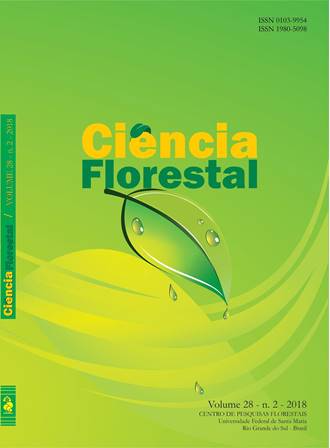EFFECT OF ARTIFICIAL DEFOLIATION ON THE GROWTH OF WILLOW
DOI:
https://doi.org/10.5902/1980509832082Keywords:
Salix x rubens, phytomass, assimilate partitioning.Abstract
The willow (Salix x rubens) is a woody plant of European origin, used in Brazil for handicrafts and furniture. This culture is eventually attacked by caterpillars and ants, which cause the loss of the leaf area. This study aimed to evaluate the effect of levels of defoliation on the growth of willow. The experiment was conducted in a greenhouse. The plants were kept in pots with a capacity of 8 liters under intermittent mist, from August to December 2004. The design was a randomized block with five replications and four treatments (0, 25, 50 and 75% defoliation of the total number of leaves) were evaluated for reducing sugar content, leaf area and fresh and dry stems and leaves. The defoliation reduced the final weight (WR = -0,1067x + 19,03, R² = 0,98) and diameter of the rods (DM = -0,0114x + 5,172, R² = 0,98), and the leaf weight (MF = -0,1028x + 13,892; R2 = 0,99) and leaf number (NF = -0,2545x + 36,87, R² ~ 0,998). The partition of assimilates has been modified in favor of the restoration of leaf area.
Downloads
References
AGRAWAL, A. A.; KOSOLA, K. R.; PARRY, D. Gypsy moth defoliation and N fertilization affect hybrid poplar regeneration following coppicing. Canadian Journal of Forest Research, New Westminster, v. 32, p. 1491-1495, 2002.
BENNETT J. et al. Influence of defoliation on overwintering carbohydrate reserves, return bloom, and yield of mature Chardonnay grapevines. American Journal of Enology and Viticulture, Davis, v. 56, n. 4, p. 386-393, 2005.
BRADFORD, M. M. Rapid and sensitive method for quantification of microgram quantities of protein utilizing principle of protein dye binding. Analytical Biochemestry, New York, v. 72, p. 248-254, 1976.
CANDOLFI-VASCONCELOS, M. C.; KOBLET, W. Influences of partial defoliation on gas exchange parameters and chlorophyll content of field-grown grapevines: mechanisms and limitations of the compensation capacity. Vitis, Siebeldingen, v. 30, p. 129–141, 1991.
CEDERVIND, J. Impact of Pine Looper Defoliation in Scots Pine. 2003. 44 f. Tese (Doutorado) - Swedish University of Agricultural Sciences, Uppsala, 2003.
CHEN, Z.; KOLB, T. E.; CLANCY, K. M. Effects of artificial and western spruce budworm (Lepidoptera: Tortricidae) defoliation on growth and biomass allocation of douglas-fir seedlings, Journal of Economic Entomology, Lanham, v. 95, n. 3, p. 587-594, 2002.
COYLE, D. R. et al. Cottonwood leaf beetle (Coleoptera: Chrysomelidae) defoliation impact on Popolus growth and above-ground volume in a short-rotation woody crop plantation. Agricultural and Forest Entomology, Oxford, v. 4, p. 293-300, 2002.
EMPRESA DE PESQUISA AGROPECUÁRIA E EXTENSÃO RURAL DE SANTA CATARINA. Sistema para a produção de vime. Florianópolis: Epagri, 2006. 40 p. (Epagri - Sistemas de Produção, n. 44).
ERBILGIN, N. et al. Resource availability and repeated defoliation mediate compensatory growth in trembling aspen (Populus tremuloides) seedlings. PeerJ, San Diego, v. 2, p. e491, 2014. Disponível em: <https://www.ncbi.nlm.nih.gov/pmc/articles/PMC4106189/>. Acesso em: 20 mar. 2017. doi: 10.7717/peerj.491.
FILIPPETO, L. Influência da desfolha natural sobre o comportamento vegetativo e qualidade de produção da safra seguinte da uva Cabernet Sauvignon. 2008. 55 f. Monografia (Graduação em Enologia) - Centro Federal de Educação Tecnológica de Bento Gonçalves, Bento Gonçalves, 2008.
HUDGEONS, J. L. et al. Defoliation by introduced Diorhabda elongata leaf beetles (Coleoptera: Chrysomelidae) reduces carbohydrate reserves and regrowth of Tamarix (Tamaricaceae). Biological Control, Lexington, v. 43, n. 2, p. 213-221, 2007.
ISLAM, M. T. Effects of defoliation on photosynthesis, dry matter production and yield in soybean. Bangladesh Journal of Botanic, Bangladesh v. 43, n. 3, p. 261-265, 2014.
KÖRNER, C. Cottonwood leaf beetle (Coleoptera: Chrysomelidae) defoliation impact on Popolus growth and aboveground volume in a short-rotation woody crop plantation. Journal of Ecology, London, v. 91, p. 4-17, 2003.
KOSOLA, K.R. et al. Repeated insect defoliation effects on growth, nitrogen acquisition, carbohydrates, and root demography of poplars. Oecologia, Heidelberg, v. 129, p. 65–74, 2001.
KRUGER N.J. The Bradford Method for Protein Quantitation. In: Walker J.M. (eds) Basic Protein and Peptide Protocols. Methods in Molecular Biology: Humana Press, v. 32, p. 9-15, 1994
LAMP, W. O.; BRITT. N. W. The resource partitioning by two species of stream mayflies (Ephemeroptera: Heptageniidae). Great Lakes Entomologist, Michigan, v. 14, n. 3, p. 151-158, 1981.
LOESCHER, H.; MCCAMANT, T.; KELLER, J. D. Carbohydrate reserves, translocation, and storage in woody plant roots. Hortscience, Wayne, v. 25, n. 3, 1990.
MANDRE, M.; TULLUS, H.; KLOSEIKO, J. Partitioning of Carbohydrates and Biomass in Scots Pine. Zeitschrift für Naturforschung, Mainz, v. 57, p. 296-302, 2002.
MILLER, G. L. Use of dinitrosalicylic acid reagent for determination of reducing sugar. Analytical chemistry, Washington, v. 31, n. 3, p. 426-428, 1959.
SILVA, G. O vime – cultivo e arte. Globo Rural, Rio de Janeiro, v. 169, p. 48-52, nov. 1999.
SOCIEDADE BRASILEIRA DE CIÊNCIA DO SOLO. Recomendação de adubação e calagem para os estados do Rio Grande do Sul e de Santa Catarina. 3.ed. Passo Fundo, RS: SBCS/Núcleo Regional Sul; Comissão de Fertilidade do Solo – RS/SC, 1994. 224p.
SOUZA, E. R. et al. Variação de carboidratos em folhas da videira ‘Itália’ submetida a diferentes de níveis de desfolhas. Revista Brasileira de Ciências Agrárias, Recife, v. 8, n. 4, p. 535-539, 2013. Disponível em: <http://ainfo.cnptia.embrapa.br/digital/bitstream/item/96541/1/Barbara.pdf>. Acesso em: 02 ago. 2016.
TAGLIARI, P. O vime. Revista Agropecuária Catarinense, Florianópolis, v. 4, p. 45-47, 1998.
VOLIN, J. C.; KRUGER, E. L.; LINDROTH, R. L. Responses of deciduous broadleaf trees to defoliation in a CO2 enriched atmosphere. Tree Physiology, Victoria, v. 22, p. 435-448, 2002.
WARGO, P. M. Consequences of environmental stress on oak: predisposition to pathogens. Annales des Sciences Forestières, Versailles, v. 53, n. 2-3, p. 359-368, 1996.







